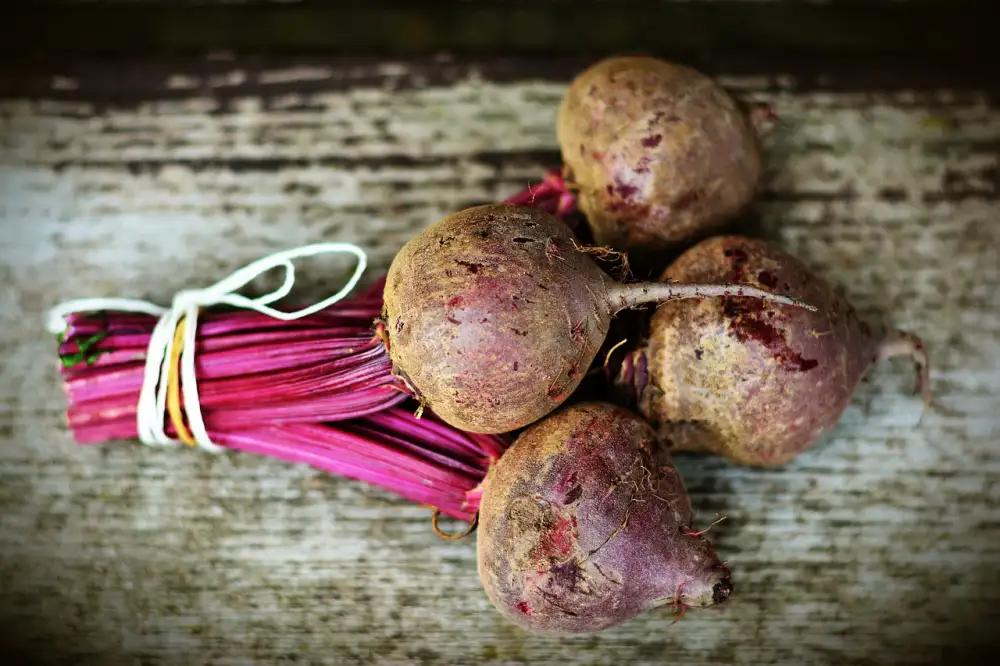Preserving the Harvest: A Step-by-Step Guide on How to Pickle Beets

Pickling is a time-honored method of preserving fruits and vegetables, allowing us to enjoy their flavors long after the harvest season has ended. One such vegetable that can be transformed into a tangy and delicious pickle is the beet. With its vibrant color and earthy taste, pickled beets add a delightful crunch and zing to salads, sandwiches, and even charcuterie boards. In this step-by-step guide, we will explore the art of pickling beets, from gathering the necessary ingredients to storing and enjoying your homemade jars of pickled goodness. So roll up your sleeves and let's dive into the world of pickling beets!
Gathering the necessary ingredients for pickling beets
To start your pickling adventure, gather the necessary ingredients for pickling beets. You will need fresh beets, preferably small to medium-sized ones, as they are easier to handle and pickle evenly. Other essential ingredients include vinegar (white or apple cider), water, sugar, salt, and various spices such as cloves, cinnamon sticks, and peppercorns. Don't forget to have some clean glass jars with tight-fitting lids on hand for storing your delicious pickled beets.
Preparing the beets for pickling
Preparing the beets for pickling is an important step to ensure that they are ready to absorb the flavors of the brine. Start by washing the beets thoroughly under cold running water to remove any dirt or debris. Trim off the beet greens, leaving about an inch of stem intact. This will prevent the beets from bleeding too much color during cooking. Next, place the beets in a large pot and cover them with water. Bring the water to a boil and cook the beets until they are tender when pierced with a fork, usually around 30-40 minutes depending on their size. Once cooked, drain the beets and allow them to cool slightly before handling. Use your hands or a paring knife to peel off the skin, which should easily slide off at this point. Trim off any remaining stems or roots, and slice or dice the beets according to your preference. The prepared beets are now ready for pickling!
Creating the pickling brine
Creating the pickling brine is a crucial step in the process of pickling beets. The brine not only adds flavor to the beets but also helps preserve them. To create the perfect pickling brine, you will need vinegar, water, sugar, and salt.
Start by combining equal parts vinegar and water in a large saucepan. The amount of liquid you need will depend on how many beets you are pickling. For every cup of liquid, add 1 tablespoon of sugar and 1 teaspoon of salt.
Bring the mixture to a boil over medium heat, stirring until the sugar and salt dissolve completely. This will ensure that the flavors are evenly distributed throughout the brine.
Once the brine has come to a boil and all the ingredients have dissolved, remove it from heat and let it cool completely. This step is important as pouring hot brine over the beets can cause them to become mushy.
While waiting for the brine to cool, you can prepare your beets for pickling by peeling and slicing them into your desired shape or size.
Once both the brine and beets are ready, carefully pour the cooled brine over the beets in a sterilized jar or container. Make sure that all the beets are fully submerged in the brine.
Seal the jar tightly with a lid and refrigerate for at least 24 hours before enjoying your homemade pickled beets. The longer they sit in the brine, the more flavorful they will become.
Remember that pickled beets taste best when allowed to marinate for several days before consuming. So exercise patience and resist temptation!
Experimenting with different types of vinegar or adding spices like cloves or peppercorns can also add an extra layer of flavor to your pickled beets. Don't hesitate to get creative with your own variations!
In conclusion, creating a delicious pickling brine is an essential step in the process of pickling beets. With the right combination of vinegar, water, sugar, and salt, you can transform fresh beets into a tangy and flavorful treat that can be enjoyed for months to come. So roll up your sleeves and get ready to preserve the harvest by pickling some beets!
Pickling the beets
Pickling the beets is a simple and rewarding process that will preserve their vibrant color and earthy flavor. Once you have prepared the beets and created the pickling brine, it's time to start pickling.
1. Carefully place the prepared beets into sterilized jars, leaving about 1 inch of headspace at the top.
2. Slowly pour the pickling brine over the beets, making sure they are completely covered. Use a knife or spatula to remove any air bubbles trapped in the jar.
3. Seal the jars tightly with sterilized lids and rings.
4. Place the jars in a cool, dark place for at least one week to allow the flavors to develop. The longer you let them sit, the more flavorful they will become.
5. After the recommended pickling time has passed, open a jar and taste a beet to check if it has reached your desired level of tartness and tenderness. If not, reseal and continue pickling for a few more days.
Remember that pickled beets improve with age, so it's worth waiting a bit longer for optimal flavor. Once opened, store them in the refrigerator for up to several months.
Pickled beets can be enjoyed in various ways – as a side dish, added to salads or sandwiches, or even as an ingredient in other recipes like relishes or chutneys.
Experiment with different spices and herbs to create unique flavor combinations. Some popular additions include cloves, cinnamon sticks, dill seeds, or bay leaves.
So go ahead and try your hand at pickling beets! It's a wonderful way to extend their shelf life while adding tangy goodness to your meals.
Storing and enjoying pickled beets
Once you have successfully pickled your beets, it is important to store them properly to ensure their freshness and flavor. Transfer the pickled beets into clean, sterilized jars, making sure they are completely submerged in the brine. Seal the jars tightly and store them in a cool, dark place such as a pantry or cellar.
Pickled beets can be enjoyed immediately after pickling, but for best results, allow them to sit for at least one week to fully develop their flavors. The longer they sit, the more intense and tangy the taste will become.
When you're ready to enjoy your pickled beets, there are countless ways to incorporate them into your meals. They make a delicious addition to salads, sandwiches, and wraps. You can also serve them alongside grilled meats or cheese platters for added color and tanginess.
Remember that pickled beets have a long shelf life if stored properly. They can last up to one year in the refrigerator without losing their quality. However, once opened, it is recommended to consume them within a few weeks for optimal taste.
So go ahead and savor the sweet yet tangy flavors of your homemade pickled beets. Their vibrant hues and zesty taste will surely elevate any dish they accompany.
Variations and additional tips for pickling beets
1. Experiment with flavors: Add spices like cloves, cinnamon, or bay leaves to the pickling brine for a unique taste.
2. Sweeten it up: For a sweeter pickle, add sugar or honey to the brine. This will balance out the natural earthiness of the beets.
3. Get creative with vinegar: While white vinegar is commonly used, you can also try apple cider vinegar or red wine vinegar for different flavor profiles.
4. Add some heat: If you enjoy spicy food, consider adding chili flakes or jalapenos to the pickling brine for a fiery kick.
5. Play with colors: Mix different varieties of beets, such as golden beets and Chioggia beets, to create visually stunning jars of pickled beets.
6. Let them marinate: Allow the pickled beets to sit in the refrigerator for at least a week before consuming. This will enhance their flavor and texture.
7. Serve them creatively: Pickled beets are versatile and can be enjoyed in various ways - as a side dish, on sandwiches, in salads, or even as a topping for burgers.
Remember, pickling is an art form that allows you to experiment and customize flavors according to your preferences. So don't hesitate to get creative and have fun while preserving your harvest!
Conclusion and Final Thoughts on Pickling Beets
Pickling beets is a wonderful way to preserve their vibrant color and earthy flavor. Whether you're a seasoned pickler or just starting out, this step-by-step guide has provided you with all the information you need to successfully pickle your own beets.
By following these simple steps, you can transform fresh beets into tangy, crunchy delights that will add a burst of flavor to any dish. The pickling brine allows the beets to develop a unique taste profile that complements their natural sweetness.
Remember to gather high-quality ingredients and take the time to properly prepare your beets before pickling. This ensures that your end result will be delicious and satisfying.
Once your beets are pickled, store them in an airtight container in the refrigerator for up to several months. They make a fantastic addition to salads, sandwiches, or even enjoyed on their own as a flavorful snack.
Don't be afraid to experiment with different variations of pickling spices and flavors. Add some heat with chili flakes or try incorporating herbs like dill or thyme for an extra layer of complexity.
In conclusion, pickling beets is not only a practical way to preserve the harvest but also an opportunity to explore new flavors and enhance your culinary repertoire. So go ahead, grab some fresh beets and start pickling – you won't regret it!
Published: 15. 12. 2023
Category: Recipes



